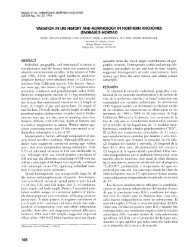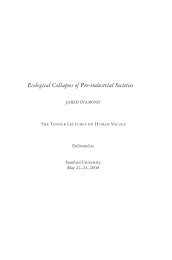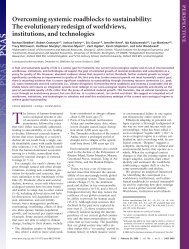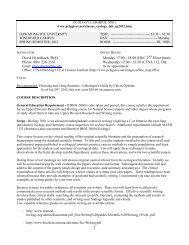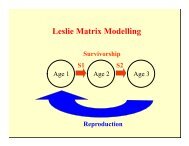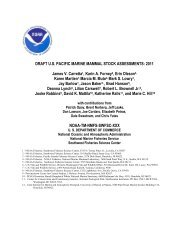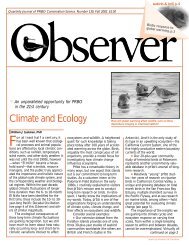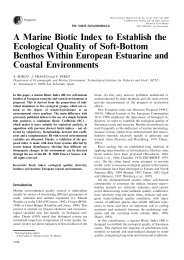A Unique Advantage for Giant Eyes in Giant Squid - Duke Biology ...
A Unique Advantage for Giant Eyes in Giant Squid - Duke Biology ...
A Unique Advantage for Giant Eyes in Giant Squid - Duke Biology ...
Create successful ePaper yourself
Turn your PDF publications into a flip-book with our unique Google optimized e-Paper software.
Please cite this article <strong>in</strong> press as: Nilsson et al., A <strong>Unique</strong> <strong>Advantage</strong> <strong>for</strong> <strong>Giant</strong> <strong>Eyes</strong> <strong>in</strong> <strong>Giant</strong> <strong>Squid</strong>, Current <strong>Biology</strong> (2012),doi:10.1016/j.cub.2012.02.031Current <strong>Biology</strong> Vol 22 No 82Figure 1. Fresh Head of a <strong>Giant</strong> <strong>Squid</strong> with a 90 mm PupilThe squid was caught on February 10, 1981 by fisherman Henry Olsen about10 miles offshore from Kahana Bay, Oahu, HI, and the picture was taken byErnie Choy at the pier. The squid is likely to be of the genus Architeuthis.Scale bar represents 200 mm (calibrated by the standard fuel hose acrossthe pupil).organisms throughout the water column [14, 18–20]. Suchstimulated biolum<strong>in</strong>escence can reveal the mov<strong>in</strong>g objecteither as a number of <strong>in</strong>dividually visible po<strong>in</strong>t sources or asan extended source without resolution of the <strong>in</strong>dividual sources[21].For extended source detection, we assume an optimumstrategy based on dynamic pixels that match the width ofthe object to be detected (optimal spatial summation[22, 23]), but <strong>for</strong> po<strong>in</strong>t source detection, we assume pixelscorrespond<strong>in</strong>g to <strong>in</strong>dividual photoreceptor cells [16, 23] (Figure2A). For both po<strong>in</strong>t sources and extended objects, detectionis a discrim<strong>in</strong>ation task where a target pixel has to providea signal based on the number of detected photons, N T , that isstatistically different from that of an identical reference pixel,N B , view<strong>in</strong>gpthe background next to the target [24],jN T 2 N B jRRffiffiffiffiffiffiffiffiffiffiffiffiffiffiffiffiffiffi N T 2 N B , where R is a confidence factor set to1.96 <strong>for</strong> 95% confidence [24]. We develop this relationshipwith expressions <strong>for</strong> ocean light, water properties, eye geometry,visual optics, and photoreceptor properties and deriveequations that relate the pupil diameter to the maximum detectiondistance (range of vision). The solutions are developedseparately <strong>for</strong> detection of po<strong>in</strong>t sources, black extendedobjects, and lum<strong>in</strong>ous extended objects. The result<strong>in</strong>g equations,their derivations, and notes on the numerical valuesused <strong>for</strong> model<strong>in</strong>g are found <strong>in</strong> Supplemental In<strong>for</strong>mation.Model<strong>in</strong>g Visual RangeThe theory turns out to be a powerful general tool <strong>for</strong> analyz<strong>in</strong>gvisual strategies <strong>in</strong> the pelagic habitat. A strik<strong>in</strong>g result is thatthe range of vision, irrespective of depth <strong>in</strong> the sea, or view<strong>in</strong>gdirection, follows a law of dim<strong>in</strong>ish<strong>in</strong>g returns when the eye<strong>in</strong>creases <strong>in</strong> size (Figure 2B). This phenomenon depends onthe absorption and scatter<strong>in</strong>g of water and is unique <strong>for</strong>aquatic vision. The different visual strategies (detection ofpo<strong>in</strong>t sources, black extended objects, and lum<strong>in</strong>ousextended objects) follow slightly different curves, but all result<strong>in</strong> a gradually decreas<strong>in</strong>g per<strong>for</strong>mance ga<strong>in</strong> when the eyegrows larger. Increas<strong>in</strong>g the eye size gives markedly bettervision up to a pupil diameter of about 25 mm. Further <strong>in</strong>creases<strong>in</strong> eye size become gradually much less reward<strong>in</strong>g, and thisoffers a good explanation to why pelagic animals <strong>in</strong> generaldo not have pupil diameters exceed<strong>in</strong>g 30–35 mm. Witha typical ratio of about 2.5–3 between focal length and pupildiameter <strong>in</strong> aquatic eyes [1], this corresponds to eye diametersof about 90 mm, which agrees with the upper bound of eyediameters <strong>in</strong> fish.Our model<strong>in</strong>g clearly demonstrates how the different detectionstrategies vary with depth <strong>in</strong> the sea (Figure 2C). In shallowwater, extended objects are best detected as dark silhouettesaga<strong>in</strong>st the brighter space light. But <strong>in</strong> deep water, the sameobjects can be seen at long range, <strong>in</strong> reverse contrast, if theobjects trigger plankton biolum<strong>in</strong>escence as they movethrough the water. Detection of <strong>in</strong>dividual po<strong>in</strong>t sources is <strong>in</strong>effective<strong>in</strong> the bright daylight of shallow water but becomesa competitive strategy <strong>in</strong> the darkness at both moderate andgreat depths <strong>in</strong> the sea. However, the situation is morecomplex than <strong>in</strong>dicated by Figure 2C, because the relativemerits of the different view<strong>in</strong>g strategies also depend on eyesize, object size, and view<strong>in</strong>g direction, as illustrated <strong>in</strong> Figure3A. Under most conditions, po<strong>in</strong>t source detectionprovides the longest visual range, except at shallow depthswhere detection of dark silhouettes is superior, especially <strong>for</strong>the upward view<strong>in</strong>g direction where the background is thebrightest. The only notable feature that sets very large eyesapart is that they are superior <strong>in</strong> detect<strong>in</strong>g large lum<strong>in</strong>ousobjects at depths below about 500 m. The reason <strong>for</strong> this isthat visual contrasts at long range are extremely low andrequire both a large pupil area and summation over a largetarget to generate statistically detectable differences betweenobject and background. Thus, the very large eyes of giantsquid offer a unique advantage <strong>for</strong> long-range detection ofbiolum<strong>in</strong>escence triggered by large mov<strong>in</strong>g objects.In pelagic animals, the impact that vision has on fitness islikely to be determ<strong>in</strong>ed not by the detection distance but ratherby the water volume the eye can monitor. This is plotted <strong>in</strong> Figure3B, and it reveals that, at 600 m or deeper, extended sourceview<strong>in</strong>g offers the best per<strong>for</strong>mance <strong>for</strong> detection of predatorsizelum<strong>in</strong>ous objects through pupil diameters exceed<strong>in</strong>gabout 30 mm. Selection driven by this detection strategymay thus favor even larger eyes <strong>in</strong> animals that already haveeyes of substantial size. To analyze how much it pays to<strong>in</strong>crease the eye size, we calculated the <strong>in</strong>crease <strong>in</strong> visualper<strong>for</strong>mance generated by a fractional <strong>in</strong>crease <strong>in</strong> eye size.The results, summarized <strong>in</strong> Figure 3C, reveal that the visualstrategy provid<strong>in</strong>g the best return <strong>for</strong> eye growth co<strong>in</strong>cidesrather well with the best per<strong>for</strong>m<strong>in</strong>g visual strategy (Figure 3A).For large eyes, extended view<strong>in</strong>g of lum<strong>in</strong>ous objects is thusnot only the best visual strategy <strong>for</strong> detect<strong>in</strong>g large predators<strong>in</strong> deep water (Figure 2A), but it is also the strategy that moststrongly motivates an <strong>in</strong>crease <strong>in</strong> eye size. The functions ofFigure 3D show that the per<strong>for</strong>mance return <strong>for</strong> <strong>in</strong>creases <strong>in</strong>eye size from an eye with a 30 mm pupil to one with a 90 mmpupil is uniquely high <strong>for</strong> the task of detect<strong>in</strong>g objects thatare very much larger than the squid itself (predator width, 2m). For conspecific-size objects or <strong>for</strong> biolum<strong>in</strong>escent po<strong>in</strong>tsources, the per<strong>for</strong>mance return is less than half as good,and <strong>for</strong> prey-size extended objects, less than 10 times asgood as it is <strong>for</strong> detection of the large, predator-size objects.Extended source view<strong>in</strong>g of predator-size lum<strong>in</strong>ous objectsthus offers the unique motivation <strong>for</strong> huge eyes that we aresearch<strong>in</strong>g <strong>for</strong>. A more general <strong>in</strong>terpretation of the calculationsis that <strong>for</strong> dim-light vision <strong>in</strong> water, low-resolution tasks motivatemuch larger eyes than high-resolution tasks.Because our model<strong>in</strong>g relies on assumptions of a largenumber of variables, we cannot trust the calculations to be



